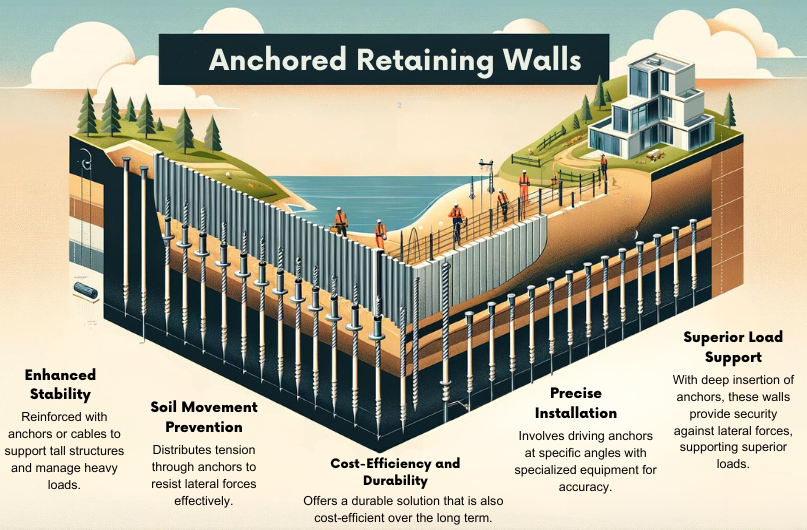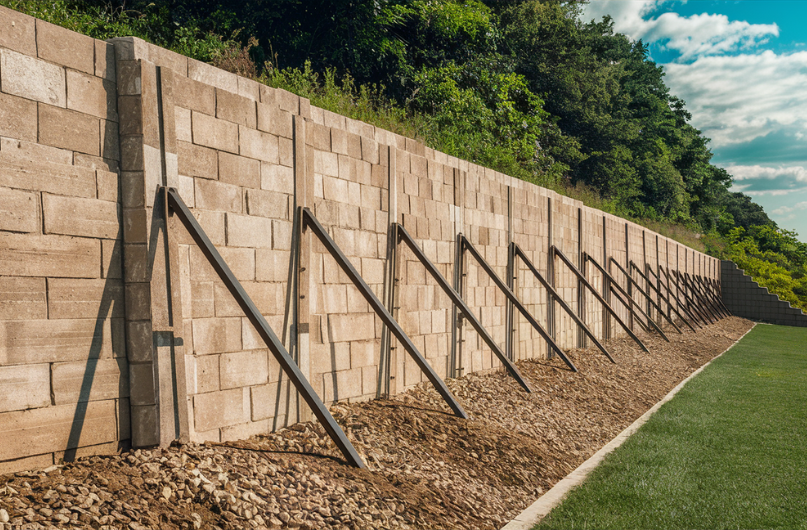Anchor retaining walls, essential for stabilizing terrain, rely on anchoring cables or rods for stability and support. These walls prevent downhill soil movement by distributing tension through anchors, resisting lateral forces with deep insertion, and transferring loads securely. The installation process involves driving anchors at specific angles, ensuring stability with precise alignment, and using specialized equipment for accuracy. If you seek to understand more about the components, design elements, advantages, and applications of anchored retaining walls, there is a wealth of information available on these topics.

Anchored retaining walls, reinforced by anchors or cables, are essential structures designed to provide added stability and support, especially for tall walls or those supporting heavy loads. The benefits of anchored walls lie in their ability to prevent soil or materials from moving downhill, thereby ensuring the wall's structural integrity. When considering the design of anchored retaining walls, several key factors need to be considered. The type and spacing of anchors or cables, the depth and inclination of the wall, and the soil conditions all play an important role in determining the effectiveness of the structure.
Design considerations for anchored retaining walls include selecting appropriate anchor materials, such as steel or grouted rods, based on the project's specific requirements. Additionally, the load-bearing capacity of the anchors must be carefully calculated to withstand the forces exerted on the wall. Proper drainage behind the wall is also essential to prevent water buildup, which can compromise the stability of the structure. By carefully addressing these design considerations, anchored retaining walls can effectively support tall structures and heavy loads while ensuring long-term stability.
When considering the components of anchored retaining walls, you must focus on essential elements like:
One pivotal component of anchored retaining walls is the inclusion of anchoring cables or rods for improved stability. These elements play a vital role in maintaining the structural integrity of the wall by providing lateral support and preventing potential soil movement.
When considering the design of anchored retaining walls, engineers carefully select materials that offer durability and strength, such as reinforced concrete or steel. Design considerations also include the wall's height and depth, typically ranging from 6-18 meters in height and 8-24 centimeters in depth.

The anchor system in retaining walls comprises horizontal steel tie rods or steeply raking tie rods, providing essential stability to the structure. These components play a vital role in ensuring the integrity and longevity of the wall. Here are some key functions of the anchor system:

To guarantee the structural integrity of anchored retaining walls, the components play a crucial role in maintaining stability and preventing potential failures. Proper anchoring is of utmost importance for the overall stability of these structures.
Anchored retaining walls benefit greatly from components such as deadman anchors and bearing piles, which are essential for ensuring the stability of thin walls in challenging conditions. Engineers who specialize in geotechnical aspects meticulously design these components to withstand high loads and limited spaces effectively.
The benefits of these components extend to the overall performance and longevity of anchored retaining walls, making them indispensable for the successful construction and functionality of these structures in various geotechnical settings.
When installing anchors in an anchored retaining wall, you drive them deep into the soil or rock at an angle to bolster lateral pressure.
This installation method fortifies the wall's stability and structural integrity.
The anchoring system works in conjunction with the wall design to create a durable and effective retaining structure.
By driving anchors deep into the soil or rock at a specific angle, anchored retaining walls gain lateral support essential for their stability and load distribution.
The stability mechanism of anchored retaining walls relies on the strategic placement and utilization of anchors or cables for improved structural support and load distribution. Soil stability is achieved by deep insertion of anchors into the soil or rock, effectively resisting lateral forces that could compromise the wall's integrity.
Anchor technology plays a vital role in the overall stability of these walls, allowing them to handle heavier loads and prevent soil movement downhill. By transferring the load from the wall to the anchors, the system guarantees that the structure remains secure and reliable.
This working principle is fundamental in enhancing the wall's capacity to withstand external pressures and maintain its structural integrity over time.
To initiate the installation process of anchored walls, begin by preparing the site through soil movement and hole excavation. This important step sets the foundation for the stability of the structure. Once the site is ready, follow these steps:
Following these steps meticulously is essential to guarantee the strength and stability of the anchored retaining wall. Each step contributes to the overall effectiveness of the anchoring system, providing the necessary support for the wall structure.
Maximizing stability and load-bearing capacity, anchored retaining walls offer numerous advantages in construction projects. These walls are cost-efficient due to their durable design, requiring lower maintenance over time. The deeply inserted anchors provide superior load support, enabling them to withstand heavier loads with ease. Their slim profile makes transportation and installation more straightforward compared to bulkier alternatives, improving construction ease.
Additionally, anchored retaining walls are highly durable, ensuring long-term reliability in slope protection and excavation support on construction sites. By combining cost efficiency, durability, enhanced load support, and construction ease, these walls present a versatile solution for various construction challenges.
Whether you need to secure steep slopes or reinforce excavation sites, anchored retaining walls stand out as a practical and reliable choice for maximizing stability and structural integrity in construction projects.
When examining case studies of anchored retaining walls, engineers frequently observe their effectiveness in supporting tall or heavily loaded structures through the integration of anchors or cables for improved stability and load-bearing capacity.
When it comes to building a retaining wall, materials and techniques matter. Our team specializes in anchored retaining wall solutions, providing unparalleled expertise and quality construction.
Anchored retaining walls utilize cables or rods anchored deep into the soil to provide exceptional stability, even on steep slopes or in areas with poor soil conditions. The anchors evenly distribute lateral forces and prevent the wall from tipping or sliding. This makes anchored walls an ideal choice for sites where gravity walls would likely fail.
With years of experience, our crew handles every phase of the retaining wall-building process. We evaluate your terrain’s unique challenges, recommend the optimal wall design, procure quality building materials, and leverage specialized equipment for safe installation. Throughout, we remain focused on building attractive, enduring walls tailored to your property’s needs.
Whether you need a small residential wall or a large commercial project, our versatility and technical know-how set us apart. We construct durable anchored retaining walls using various building materials - including concrete, blocks, stone and timber - customized to suit the aesthetics and functionality you desire.
Don’t leave your landscape’s steep terrain or erosion problems unchecked. Our expertise in anchored retaining wall solutions offers reliable stabilization and protection. Contact us today to discuss your site’s needs!
When comparing anchored retaining walls to other types, you'll find they offer a cost-efficient solution with improved durability. The deep anchors provide stability and load-bearing capacity, making them a reliable choice for longevity analysis.
In certain scenarios, limitations exist for anchored retaining walls due to high groundwater, seismic activity, or corrosive soils. Alternative solutions might be necessary in sites with access issues or unsuitable cohesive soils.
When considering stability in combined systems, anchored retaining walls can be effectively used with various wall types. Construction techniques guarantee compatibility, enhancing overall wall performance. The tie-back system provides added stability in high-load situations.
To guarantee long-term effectiveness, you should conduct regular inspections for signs of corrosion, monitor soil movement, maintain proper drainage, periodically re-tension anchor rods, and address vegetation growth. If issues arise, seek professional repair promptly.
Incorporating soil composition and drainage impact is essential for anchored walls. Stability analysis, design considerations, and construction techniques hinge on environmental factors. Performance evaluation guarantees structural integrity. Cost comparison and durability assessment are key for long-term effectiveness.
To sum up, anchored retaining walls are designed to provide stability and support to prevent soil erosion and slope failures. By utilizing anchors to secure the wall to the ground behind it, these structures can withstand significant lateral forces.
The components, working principle, and installation process all contribute to the effectiveness of anchored retaining walls. Their advantages include cost-effectiveness, versatility, and durability. Case studies demonstrate the successful implementation of anchored retaining walls in various projects.